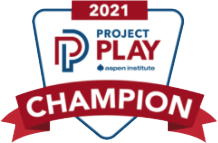Wield It Well: Youth Development & the Power of Sport
Posted by: Alex Easby | University of Denver Center for Performance Excellence (CPEX)
There’s a reason we’re all here. I don’t mean why we’re here on this planet, that’s far beyond the scope of this post. I mean the reason we’re here reading this blog, and that reason is sport. Whether we play currently, used to play, work in it or just take joy in watching it, sport is why we’re here. It’s likely if you’re reading this post, that sport’s important to you in some way: your child plays it, it forms the basis of your social circle, it pays your bills, it’s important, it has significance, it has power.
This post will address the power of sport as a tool, a vehicle for growth, particularly for children and teenagers. It will outline the why, the how and the what of the benefits of sport and the multitude of lessons it can teach. It will also highlight our role, as facilitators of learning, and how we can look to maximize the positives while learning from the inevitable challenges that sport brings for youth.
New York-based Sport Psychologist, Dr Jonathan Fader, in his book Life as Sport, addresses the analogous role sport can play in the development of life skills. Here, we’ll focus specifically on communication and resilience, qualities sport has excellent ability to foster and develop if we know how to use it. Not only could such skills make life’s navigation that little bit easier, but they’re also important for the maintenance of good mental health, at any age.
Communication
Communication, at its most basic, is the ability to send and receive messages. How much time do we spend thinking about how we communicate with one another? I’d be willing to wager, not too much, and to an extent, neither should we. With all manner of things requiring so much of our attention on any given day, why add more to the mix? Well, take healthcare for example. If you were prescribed treatment by your doctor or physician, you’d like to think you’d get it done, right? Well, according to a study by Zolnierek and DiMatteo (2009), it might not be quite that simple. The study demonstrated the profound effect that physician-patient communication has on the patient’s adherence to treatment. Adherence was found to be 19% higher when physician-patient treatment was “good”, compared to when it was judged as “poor.” So, even when something can directly and significantly impact our health, the way the information is delivered, the way it’s communicated, has a dramatic effect.
“Hold on a minute, a moment ago, you said we shouldn’t spend more time thinking about how we communicate…”
Right, and the idea is, that if we focus on teaching some straightforward techniques to children and teenagers through sport when they’re young, effective communication can become a much more automatic process, second-nature, just something they do.
Keep it practical by breaking communication down into the 3 C’s, Clear, Courteous, and Consistent
Clear – Getting the point across in a way the recipient can comprehend it. Try keeping instructions or questions short, and focus only on what’s absolutely necessary. Doing this makes it much easier for the receiver to not only understand the message but to act on anything they need to do. When things are important to us, there can be a tendency to unload all the information we can muster for us to feel like we got our point across. Often-times, all that does is confuses the way the message is heard, which presents a significant barrier to any action or resolution.
Courteous – First things first, this doesn’t mean wrapping everything you say in cotton wool. Communicating courteously means merely treating the recipient with respect, and can be one of the simplest and most impactful ways of creating connection and a reciprocal, productive relationship. At the most basic level, please, thank you, showing gratitude for someone’s time. This can extend to our ability to listen well. When someone’s responding to us, are we actively listening and maintaining appropriate eye-contact, or are we distracted by something else going on, a notification on our phone, another person, for example. All the latter does is create distance, and sends the message to the talker that we have other priorities, that we’re not genuinely invested in what’s being said.
Consistent – Consistency can come in the form of the words we use to describe things and the manner in which we deliver them. Particularly with technical tasks, like the ones involved in learning to play soccer, the words used can be vital. Consistently shifting between different words to address the same thing can be incredibly confusing for the learner, who’s likely to get frustrated and may experience a significant drop in confidence. The more consistent we can be with our language, the more concrete the communication, and the less room left for interpretation.
Consistency also relates to disposition. How are we when we deliver a message? Are we excited and energetic, or are we quiet and contemplative? Whatever your style, try and be consistent. As human beings, we appreciate congruence, things that match up, particularly with regards people’s behavior. If in one instance, a person’s calm, collected and measured, and the next they’re shouting and screaming, that makes them unpredictable, something human nature tells us we might want to be wary of. A big part of effective communication is having trust, and consistency plays a significant role in developing that.

PHOTO: ASHLEY ALLEN/GETTYIMAGES
Resilience
A second skill that sport has the power to develop is resilience, “the capacity to quickly recover from difficulties,” sometimes referred to as toughness. In the physical sense of toughness, sport can help us to pick ourselves up off the ground, dust off, and try again, but it’s the mental side of resilience, and its impact on learning and development, that we’re going to touch on here.
Sport has the unique ability to help children learn both physically and cognitively, at the same time. How we use our bodies and move them in space, often about an external stimulus such as a soccer ball or a tennis racket, and how we simultaneously solve mental problems like who to pass to, or how many goals needed to win the game, given the time remaining. Sport is also brilliantly placed to offer us opportunities to respond to losses, to mistakes, and to failures. Winston Churchill once defined success as the ability to move from one failure to another without loss of enthusiasm, quite the challenge indeed. That process becomes much easier to bare, however, when failures and mistakes are communicated and understood as a necessary step in the learning process. The book Mastery, by Robert Greene (2012), speaks of the journey to the top, the peak of the mountain that is mastery. The author writes of the journey as being less of a consistent, linear process, and more of a series of inclines and plateaus, not to mention the odd trough or two.
Where sport can help is in redefining the often intensely negative association we, including our youth, have with mistakes and failures. While of course, some disappointment is only natural, following that, it’s our role as coaches, educators, parents, and mentors, to help reframe the narrative. We can do this by asking questions like, “what did we learn?” “how can we use this to improve?” and “what do we need to work on?” helping to shift the focus from “I did badly” to “I’m learning, I can try again.” This kind of resilient mindset is something that has clear benefit for life outside of sport, supported by Fletcher and Sarkar (2013) who, in their comprehensive review of psychological resilience, suggest that “exposure to adversity in moderation can mobilize previously untapped resources, help engage social support networks, and create a sense of mastery for future adversities.”
In school, work, and our relationships, we’re offered infinite feedback that can be broadly interpreted one of two ways, “I got this wrong, I’m a bad person,” or “I got this wrong, I can learn, grow, and improve.” Whichever one we’ve been programmed to believe has a good chance of becoming our reality, a self-fulfilling prophecy. Sport can be the keyboard through which much of this programming happens, a tool to be used.
This post has outlined the potential power of sport to mould and define. A chisel to shape how we see ourselves and interpret the world around us. We’ve seen how sport, with the right direction, can help foster a resilient, growth-oriented mindset, and how simple communication techniques can have a significant impact on connection, and comprehension and adherence to direction.
These are but two of the myriad of positive benefits sport can have in developing life skills and helping our youth, the leaders of tomorrow, to thrive. The key word here, above all else, is can, for as with any tool, it’s worth depends on how it’s wielded.
References
Fader, J. (2016). Life as Sport. Boston, MA: Da Capo Press
Fletcher, D., & Sarkar, M. (2013). Psychological Resilience. European Psychologist, 18(1), 12–23. http://doi.org/10.1027/1016-9040/a000124
Greene, R. (2012). Mastery. London: Profile.
Haskard Zolnierek, K. B., & DiMatteo, M. R. (2009). Physician Communication and Patient Adherence to Treatment: A Meta-analysis. Medical Care, 47(8), 826–834. http://doi.org/10.1097/MLR.0b013e31819a5acc









